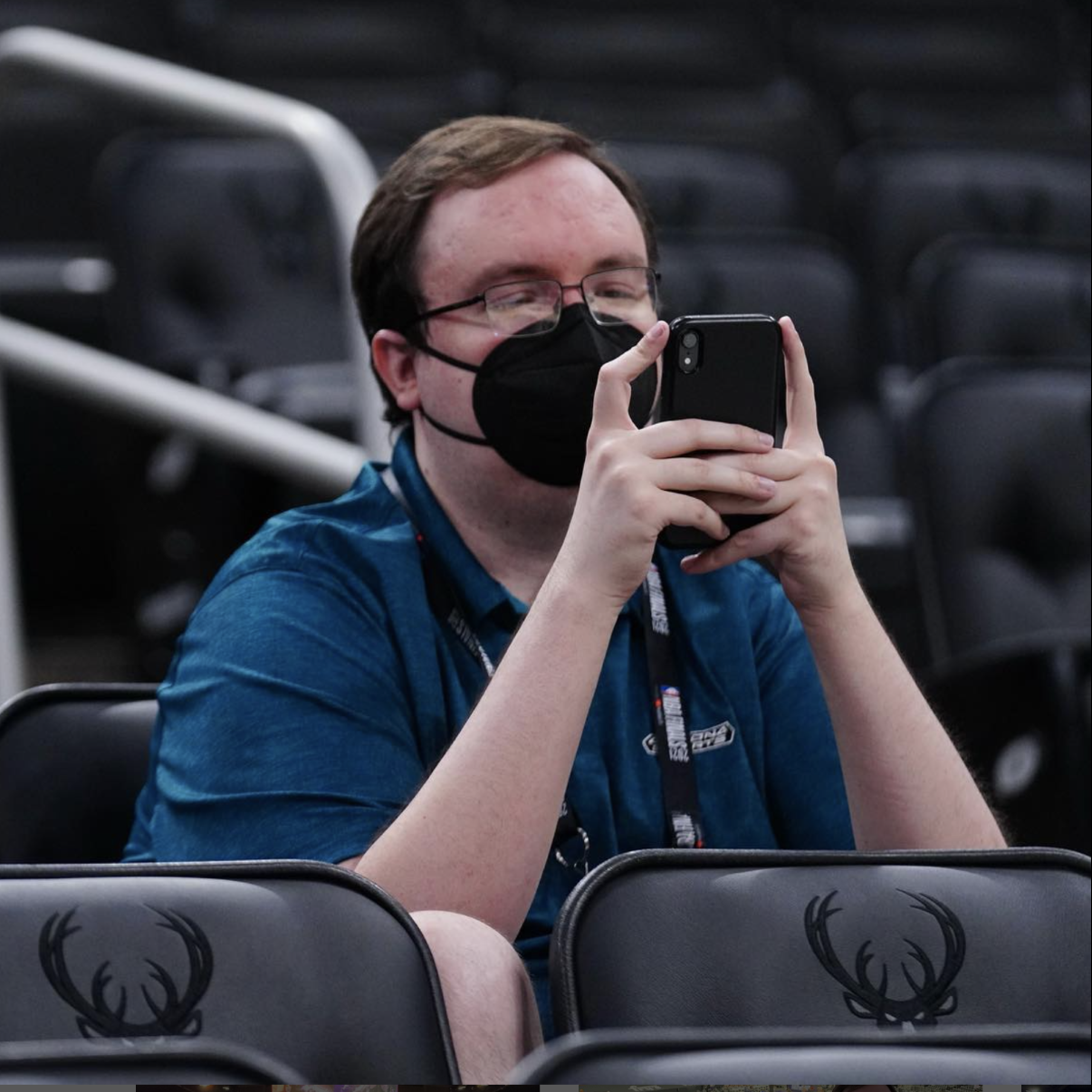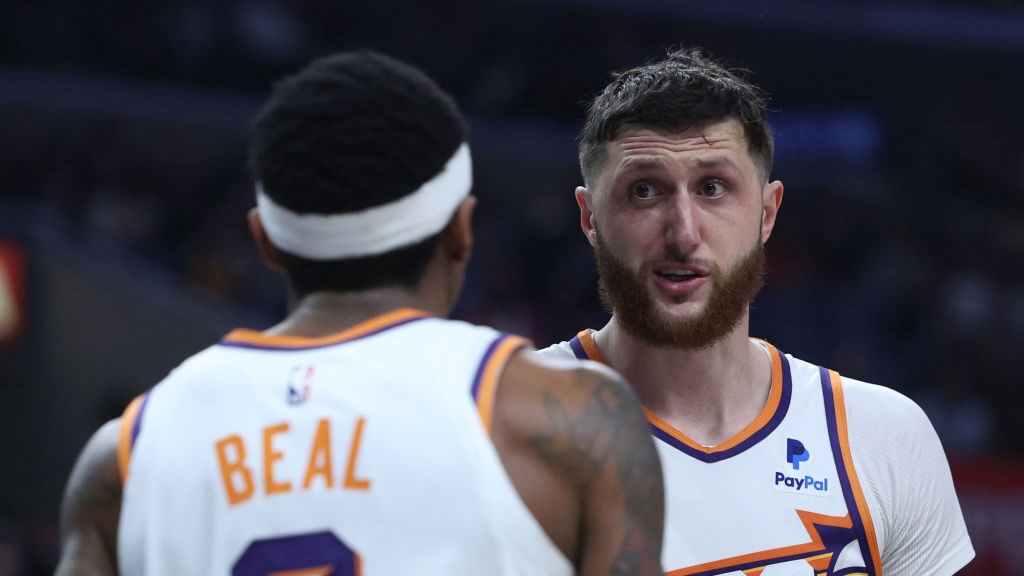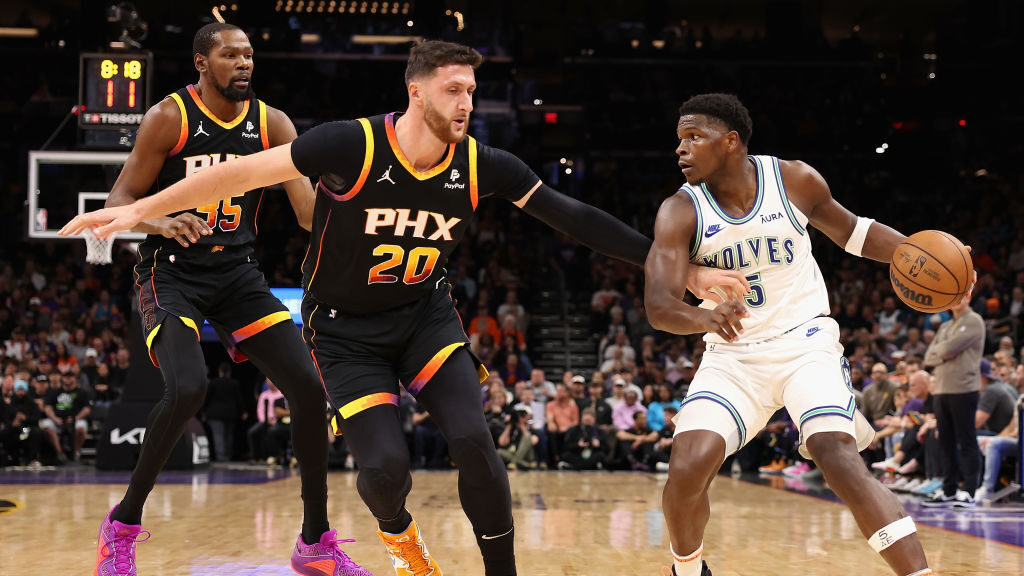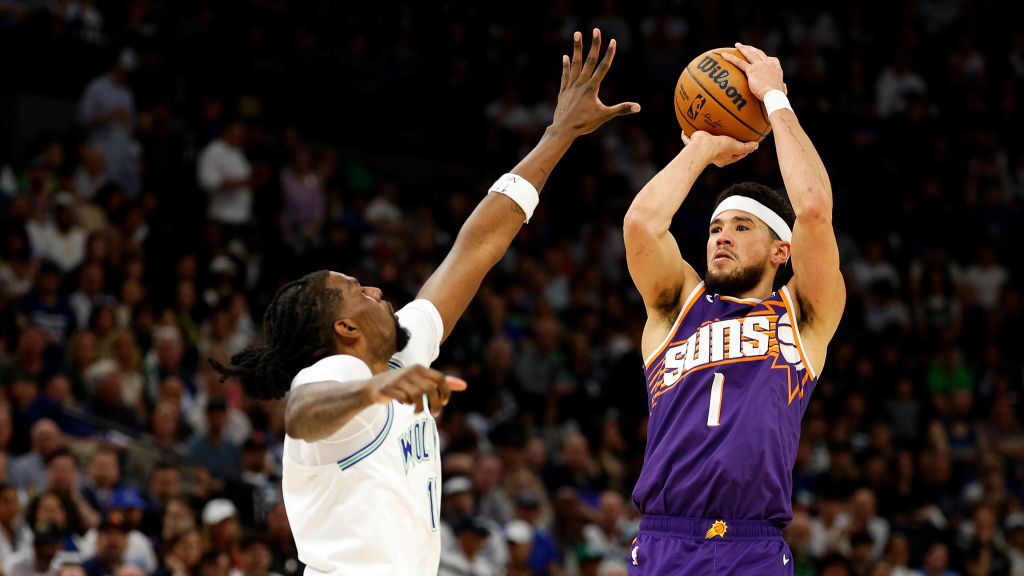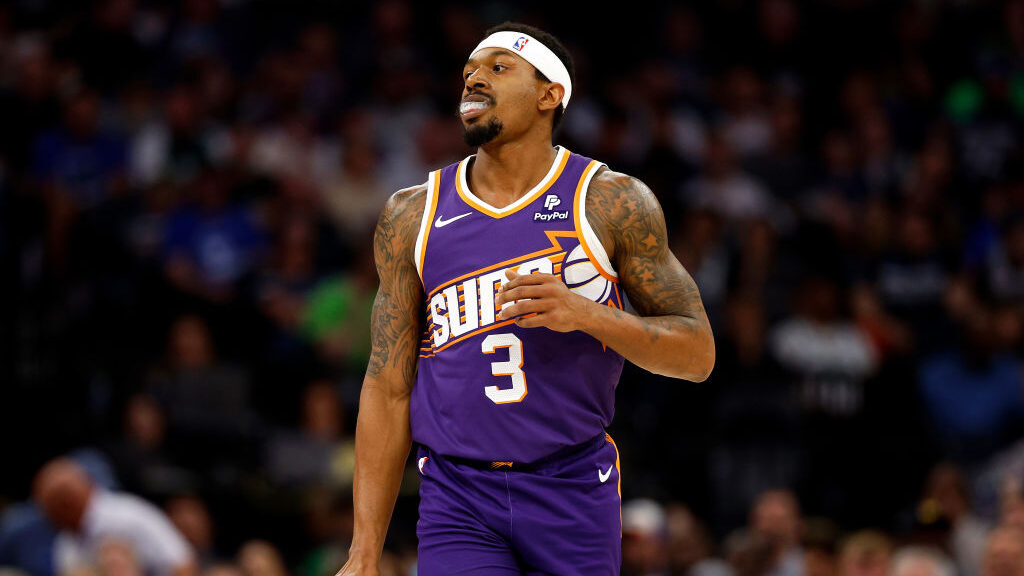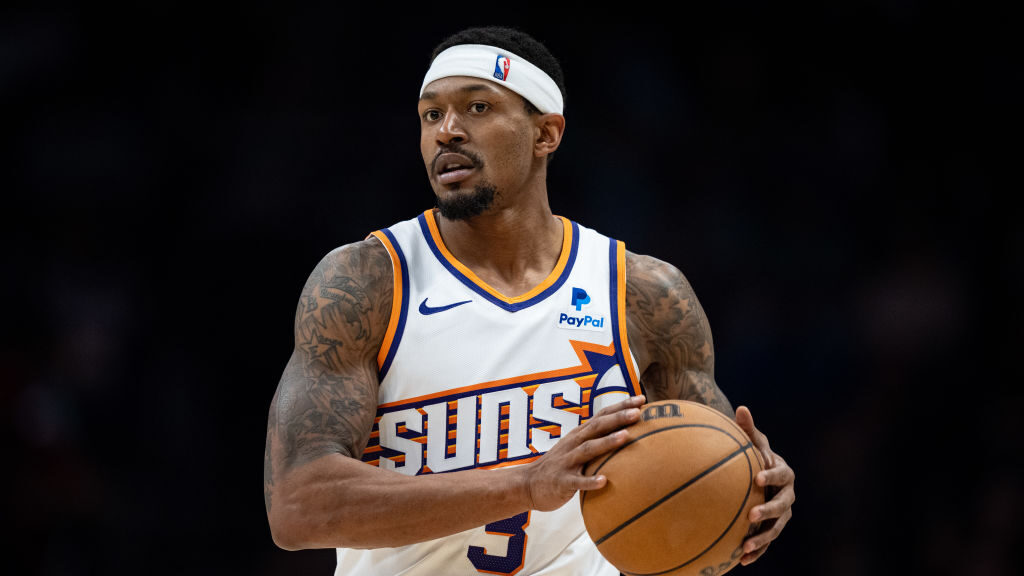Three reasons Lonzo Ball should not be in the top-3 on the Suns’ NBA Draft board
Mar 15, 2017, 7:46 AM | Updated: 2:57 pm

UCLA guard Lonzo Ball, front, picks up a loose ball as Colorado guard Deleon Brown pursues during the first half of an NCAA college basketball game late Thursday, Jan. 12, 2017, in Boulder, Colo. (AP Photo/David Zalubowski)
(AP Photo/David Zalubowski)
UCLA freshman point guard Lonzo Ball might be the most special college basketball player in over a decade.
Ball’s shooting range, supreme vision and passing ability combined with his unrelenting purpose of playing at a high pace make him one of the best athletes to watch in any sport this year.
At first glance, Ball should be the No. 1 pick in the upcoming 2017 NBA Draft.
He’s without a doubt a once-in-a-generation talent at the college level.
Does that mean, however, he will be in the pros?
There’s a chance, and depending on how likely you think it is, that’s where you have Ball ranked. DraftExpress and ESPN both have Ball ranked right behind Washington point guard Markelle Fultz.
I’ve written my thoughts on Fultz and why I believe he’s the No. 1 prospect in this year’s class.
Fultz’s appeal is that there’s not much, if anything, wrong with him as a point guard prospect.
Ball, however, has a couple of red flags, and those are why I am skeptical of using a top-three pick on him, let alone a No. 1 overall selection.
Effectiveness in halfcourt settings
Everything mentioned above about Ball makes him breathtaking in transition.
The problem in his game is what he does in the halfcourt.
His primary use is as a playmaker in a Ricky Rubio type of role, able to make any pass on the court and set up potentially the next pass or two after that leading to a bucket.
Despite his wonky-looking release (more on that later), he’s effective in catch-and-shoot situations.
Beyond that, there are a lot of questions as to what Ball is capable of.
If you’re keeping score at home, we have not discussed creating your own shot or attacking the basket, two critical keys to success for offensive point guards in the NBA.
Fifty-five of 73 of Ball’s three-point jumpers are assisted, according to Hoop-Math, much higher than a standard rate for someone who holds the ball so much, meaning one of Balls greatest weapons — the range on his jumper — is not used off the dribble on a consistent basis. For reference, Fultz’s percentage (55.8) is nearly 20 points lower than Ball’s (75.3).
As for attacking, Ball’s never been the type to attack opponents off the dribble and finish, and he still hasn’t been at UCLA.
On both ends, Ball’s effectiveness in halfcourt situations is very basic. On straight line-drive attacks to the rim, he has a very quick first step and can get to the rim in a hurry.
When asked to contort his body on the way there, take specific angles, or create additional separation, it’s a struggle.
He’s unable to consistently create separation from his man, lacks explosion off one foot to finish well at the rim and is an awkward, unnatural finisher as is.
On two-point field goals, 53.4 percent of Ball’s makes at the rim are assisted and 44 percent on jumpers. Fultz, meanwhile, ended the year at 17.4 percent at the rim and 12.5 percent on jumpers. There’s an astounding difference in the two when it comes to creating their own offense.
Defensively, Ball is actually very good in isolation situations, as shown by this sequence on Arizona’s Allonzo Trier.
Like his offense, though, adding extra variables like going through screens is a problem for him, limiting his defensive potential.
All of this adds up to a weapon that will be an unreliable offensive player in the halfcourt. For someone who does not profile as a player who can be anything more than above average defensively in his best-case scenario as an NBA player, he has to be a great offensive player as a point guard. It’s an extreme example, but the Boston Celtics’ defensive numbers don’t matter when Isaiah Thomas is on the court because the offensive numbers are better.
That’s the trade-off teams are going to have to bank on with Ball and his skills in half-court settings add a great deal of hesitation.
About that jumper …
Instead of starting with Ball’s form, we’re going to begin with his reliance on his jumper to get him going in games.
Ball is an absolute flamethrower when he is feeling it, becoming the most unguardable player in the country due to how far back he can hit his jumper and the vision to take advantage of any help defense being just an inch too close to him. Shooting 41 percent on five attempts a game with 30-foot range makes this a nightmare for defenses.
When he’s cold, however, Ball fades out of games, and the aforementioned flaws shine through.
In the 11 games this season in which Ball made less than two three-pointers, he did not score over 15 points once. For comparison, Fultz did it in eight out of his 11 games and scored over 20 in five of them.
Ball needs his jumper to be an offensive threat beyond setting up his teammates, but how gifted he is as a passer still puts a very good floor on his offensive potential.
In those 11 games, Ball had at least five assists in 10 of them while Fultz did it in seven of 11 games. The difference in them as distributors is not enough to make up for the gap as scorers.
To be fair, Ball will still be a positive in the NBA on offense, but to be one of the better point guards in the league — something one would expect by picking Ball in the top-three of a strong draft — he will have to be able to create his own offense, and the additional problems his shooting form will cause him won’t help.
The worry with Ball’s release isn’t how ugly it is, it’s how it will fare against NBA length.
In UCLA’s-then upset win over Kentucky, Ball had hit a deep three over Kentucky big man Bam Adebayo at the end of the first half.
It’s a miraculous shot, but look at how much space is between Ball and Adebayo in order for Ball to get the shot off. The pattern becomes noticeable against NBA size.
Bballbreadown took a deep look at Ball, including his shooting form. The concern is not on catch-and-shoot — where he will be fine — it’s off the dribble, where the worry elevates considerably.
As Coach Nick says in the video, Ball has a better chance going left since that’s where his feet are pointing when he releases, but there are various issues, such as going right or the deep delay he has transitioning from either the catch to the dribble or the dribble to his release that will hurt him at the next level.
Those are major details NBA teams are going to pick up on instantly.
His best-case scenario and fit in the NBA
How well Ball can settle in at the NBA level by maximizing what he’s good at to make his flaws less noticeable is going to be the biggest factor involved with his success.
It’s hard to make an argument against Ball’s spot at UCLA being anything but a best-case scenario.
UCLA thrives at playing his pace, being able to constantly make up for poor defensive effort and structure by putting up the country’s best 90.4 points a game.
The Bruins push the ball in a hurry and have no issue with those possessions going poorly, such as quickly chucking up 30-foot jumpers and giving the gift of a free transition look to their opponent.
The Bruins’ starting five alongside Ball is a dream for him. Bryce Alford and Isaac Hamilton are sharpshooter bucket-getters who can also make the right pass, T.J. Leaf is a hard-nosed stretch four who can score off the dribble and might be the second-best passer on the team and center Thomas Welsh has the best midrange jumper in the country for a perfect pick-and-pop threat.
How many boxes will NBA teams be able to check that UCLA did for Ball?
Will they play his tempo? Not every team can be the Golden State Warriors, and even in the halfcourt, the team that selects Ball will very likely have one of the worst rosters in the NBA. With his unselfish style requiring control of the offense, can Ball play off of D’Angelo Russell and Brandon Ingram in Los Angeles? What about Devin Booker and Eric Bledsoe in Phoenix?
Do they care about the reckless abandon the pace will create for a young player? The beauty in UCLA’s season is that they will never stop pushing the pace, even with the problems it creates on both ends of the floor. That rarely works in the NBA, and as Suns fans learned in the Seven Seconds or Less era, has little room for error in the hopes for a championship, and that was with a special roster.
What about the coach? Is he the right person to run this system? Mike D’Antonis do not grow on trees, and Ball hasn’t shown a great feel for the pick-and-roll, a mainstay of NBA offenses.
A team like Philadelphia makes a whole of sense for Ball, with Ben Simmons as a pass-first big who can push the ball and no one at the guard position will keep the Ball out of the two’s hands much.
The Suns, as it turns out, are somewhere near the top of the list of teams that would fit with Ball’s style.
But first and foremost, Bledsoe would have to be out of the picture. That, as I’ve written in the past, is a difficult decision, even if prospects like Fultz or Ball are available when the Suns pick in June.
After that, however, the fit with Booker is actually sound — he’s is a great secondary ball-handler and offers a ton of creation skills in the halfcourt — if he improves as a shooter, and active, athletic players like T.J. Warren, Marquese Chriss, Dragan Bender and Derrick Jones Jr. would benefit greatly from a pass-first point guard who wants to run as much as possible like Ball.
Defensively, however, the Suns’ perimeter would be a black hole. That has less to do with Ball and more to do with Booker. It is by no means a situation like UCLA, but it’s a spot where Ball would make everyone on the team better and be put in a good spot to do so — a fine compromise.
If the Suns believe Fultz and Ball are as close to impacting a team as some experts believe, Ball is the better choice because of his pass-first nature. In my opinion, though, he’s not, and playmaking options with a far higher defensive upside like Josh Jackson and Frank Ntilikina and two-way wings like Jonathan Isaac and Jayson Tatum should be in the discussion as well behind the No. 1 option in Fultz.
With Phoenix’s increased level of play since the trade deadline, however, the Suns could find themselves outside the top 3 and somewhere in the 4-6 range, a much more feasible area to take Ball.

